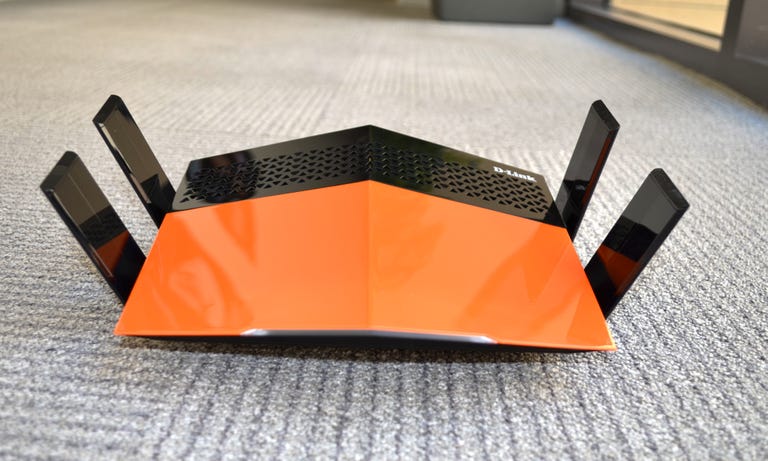 Why You Can Trust CNET
Why You Can Trust CNET D-Link DIR-879 AC1900 Wi-Fi Router review: A fast router at a slow router price
The new D-Link is a just-right router for homes, and is a great one when upgraded to the latest firmware. Here's CNET's full review.
The DIR-879 comes with four antennas that can be folded on its top.
Even the fastest laptops, tablets and phones have a capped Wi-Fi speed of 1,300Mbps -- no device on the market currently is capable of anything more. So purchasing a top-tier router, like one that supports AC5400 or AC2400 speed standards, will not likely bring you any speed benefits. The new D-Link EXO DIR-879 is an AC1900 router, meaning that as far as real-world performance goes, it's as fast as you can get, until devices with faster Wi-Fi standards become available. (Read more about Wi-Fi speeds here.) It costs $140 in the US and £174 in the UK; it's not yet on sale in Australia but the US price converts to around AU$180.
The Good
The Bad
The Bottom Line
The EXO is part of a new line of routers from D-Link with a new orange-and-black design and collapsible non-detachable antennas. The look is pleasing to my network world-weary eyes. With four Gigabit LAN ports and one Gigabit WAN port on the back, and four collapsible antennas on the sides, the DIR-879 also nails it on practicality. With no USB port or SD card slot, however, which would allow you to easily share a drive with everyone on your network, you'll instead need to connect that drive to a computer on the network.
CNET Labs' AC1900 routers' 5GHz performance
- Close range
- Long range
In testing the router supplied a sustained Wi-Fi speed -- on the 5GHz band -- of more than 635 megabits per second at close range, beating all other AC1900 routers I've tested. Farther out, at about 75 feet (with one wall in between), it still averaged out at some 435Mbps. Even on the slower the 2.4GHz band, the router put up some good numbers compared to its peers, registering 136Mbps and 74Mbps at close and long range, respectively.
The router had a long maximum range, too, topping out at about 130 feet in a residential setting before I lost the signal. It also passed our 48-hour Wi-Fi stress test without once disconnecting.
CNET Labs AC1900 routers' 2.4GHz Wi-Fi performance
- Close range
- Long range
It doesn't always deliver maximum speeds and ranges, however. As with all routers, I tested the DIR-879's two Wi-Fi bands (2.4GHz and 5GHz) as two separate Wi-Fi networks. By default though, the router combines these two bands into a single Wi-Fi network via a feature called "Smart Connect."
In this mode its Wi-Fi speed was overall noticeably slower than what I mentioned above, most likely because the router pick compatibility over performance. That said, if you want to get the best performance out of the router, I suggest you log into its web interface and turn off Smart Connect.
The preloaded firmware (version 1.01) is buggy and won't allow you to upgrade to version 1.02 automatically.
Note that I originally tested the router with the preloaded firmware version 1.01, which I found to be buggy with various issues such as random Internet disconnections, changes in the settings not being applied and so on.
After contacting D-Link, I was made aware that version 1.02 was available, but it needed to be manually installed. If you've never update a router's firmware before, this process can be a pain. You first need to extract the firmware update file out of the downloaded ZIP file. Then log in to the router's interface, go to Management, then Update to perform a manual installation. Keep in mind the router can be rendered useless if something, such as a power outage, happens during the update process. With the new firmware, I no longer experience the previous issues, at least during the time I worked with it. D-Link also says that it will soon release version 1.03 to further improve the router.
The DIR-879 shares the same web-based interface and features as previous routers from D-Link, including the DIR-890L/R and the DIR-880L. This interface is easy to use with well-organized drop-down menus and large self-explanatory buttons. You can quickly access the different settings and features with just one click. What I like most about the router's interface is the Connected Client list that displays the entire network. You can click on connected clients (each has its own type-representative icon) and make changes like adding them to the IP reservation list, or applying parental control.
But the interface isn't flawless. It has limited configuration options and lacks depth, for both settings and features throughout. For example, you can only reserve or unreserve an IP address for a client when that client is connected to the router, and there's no way to manually edit the reservation list.
Overall, the interface is great for those who just want to make quick changes to common settings, such as network names, Wi-Fi passwords and so on. For savvy users who want to customize their home network with advanced features, you won't really have that option here.
Should I get it?
At its core, the DIR-879 is a great router, but you should only get it now if don't mind having to update its firmware manually. Otherwise, hold out a month or so and the router will likely be shipped with the latest firmware.
Also note that the DIR-879 is not a must-have, unless you really love its design. There are many other better, albeit slightly more expensive AC1900 routers on the market, such as the Asus RT-AC68U or Netgear R7000, that will work out just fine for your home network.



